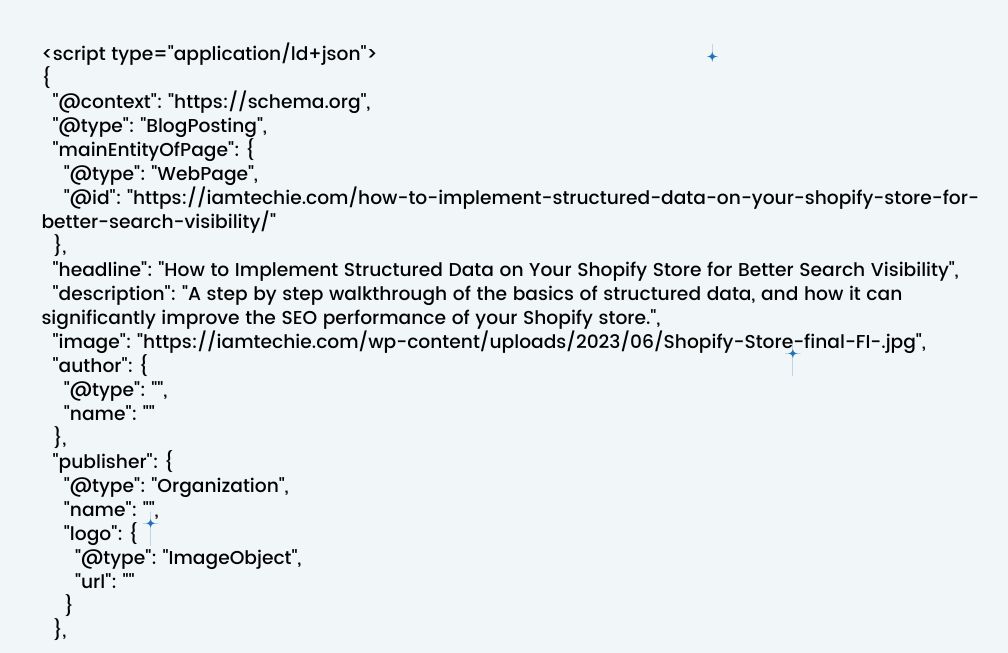When you search for products on Google, you might have noticed that important information about the product is displayed right on the search results page. These details, such as ratings, prices, availability labels, and more, are known as rich snippets. The good news is that you can also have rich snippets for your Shopify store’s product pages.
To enable rich snippets, you need to use structured data with schema markup. However, implementing schema markup on your Shopify website can be challenging, especially if you’re not familiar with coding. In this comprehensive guide, we will provide you with a step-by-step walkthrough of the basics of structured data, its different types, and how it can significantly improve the SEO performance of your Shopify store. Most importantly, we’ll show you how to add schema markup in a simple and manageable way, even if you have no prior coding experience.
By the end of this guide, you’ll have a clear understanding of structured data and its benefits. You’ll also be equipped with the knowledge and tools necessary to implement schema markup on your Shopify store, enhancing its visibility in search results and providing users with valuable information before they even visit your product pages.
Introduction To Structured Data

Structured data refers to a method of organizing and presenting data in a format that is easily understandable by machines. It involves adding additional information to web content using specific tags and properties, allowing search engines and other applications to interpret better and categorize the information.
The primary purpose of structured data is to provide context and meaning to the content, enabling search engines to deliver more accurate and relevant search results to users.
By implementing structured data, website owners can enhance the visibility and appearance of their web pages in search engine results pages (SERPs) through the generation of rich snippets.
These rich snippets often include additional information such as ratings, reviews, prices, availability, and more, providing users with a quick overview of the content before they click on the search result. Ultimately, structured data improves the user experience by presenting more comprehensive and helpful information directly in the search results.
Types of Structured Data
JSON-LD (JavaScript Object Notation for Linked Data): JSON-LD is the most recommended format for implementing structured data due to its ease of use and flexibility. It uses a script tag to embed structured data directly into the HTML code of web pages. JSON-LD is widely supported by search engines, making it a popular choice for structured data implementation.
Microdata: Microdata is an HTML specification that allows the addition of semantic annotations within the content of a web page. It uses specific attributes such as “itemtype,” “itemprop,” and “itemscope” to mark up individual elements and assign meaning to them. Microdata is relatively simple to implement but requires careful integration with existing HTML markup.
RDFa (Resource Description Framework in Attributes): RDFa is another format for embedding structured data within HTML pages. It uses HTML attributes to annotate elements with additional information. RDFa offers a high level of expressiveness and allows for more complex relationships between entities. However, it may have a steeper learning curve compared to JSON-LD and Microdata.
Common Structured Data Vocabularies (Schema.org)

Schema.org is a collaborative initiative by major search engines, including Google, Bing, Yahoo, and Yandex, to provide a standardized vocabulary for structured data markup. It offers a vast collection of schemas or types defining properties and their relationships for various entities, such as products, articles, events, organizations, etc.
Using Schema.org vocabularies, website owners can ensure that different search engines and applications understand their structured data uniformly. Schema.org provides detailed documentation, examples, and guidelines to help implement structured data correctly, enabling search engines to interpret and display the information accurately in search results.
Identifying Key Elements For Structured Data Implementation
Relevant Product Information to Include:
When implementing structured data for your website, it is essential to identify and include relevant product information. The specific details may vary depending on your industry and the nature of your products, but some common elements to consider are:
1. Product Name: Clearly specify the name or title of the product.
2. Description: Provide a concise yet informative description of the product.
3. Image: Include an image that accurately represents the product.
4. Price: Clearly state the price of the product, including any discounts or special offers.
5. Availability: Indicate whether the product is in stock, out of stock, or available for pre-order.
6. SKU or Product ID: Include a unique identifier for the product.
7. Brand: Specify the brand or manufacturer of the product.
8. Reviews and Ratings: If available, include customer reviews and ratings for the product.
9. Variants: If your products come in different variations (e.g., sizes, colors), provide details and options for each variant.
Determining Structured Data Markup for Different Pages:
Structured data markup can be applied to various pages on your website, including product pages, category pages, homepage, and more. To determine the structured data markup for each page, consider the following:
1. Product Pages: On product pages, focus on providing detailed information about the specific product. Include the relevant product information mentioned earlier, such as name, description, image, price, availability, SKU, brand, reviews, ratings, and variants.
2. Category Pages: Category pages typically showcase a collection of products within a specific category. Here, you can use structured data to highlight the category, provide a brief description, and list the products within that category. Include relevant information for each product, such as name, description, image, price, availability, and brand.
3. Homepage: The homepage of your website can also benefit from structured data. Consider including structured data for featured products, special promotions, or any other relevant information you want to highlight on the homepage.
Considering Additional Markup for Special Content:
In addition to the basic product information, specific types of content may require additional structured data markup. Some examples include:
1. Reviews and Ratings: If your website features customer reviews and ratings, consider implementing structured data specifically for this content. This markup can help search engines understand and display review snippets in search results.
2. Events: If your website promotes or hosts events, you can use structured data to provide information such as event name, date, time, location, and ticket availability. This markup can help search engines present event details directly in search results.
Implementing Structured Data on Shopify
Shopify themes and Structured Data Support
When it comes to implementing structured data on Shopify, it’s important to consider the compatibility and support provided. Fortunately, most modern Shopify themes are designed to be structured and data-friendly. These themes often include built-in support for structured data markup, making the implementation process more straightforward.
Shopify themes typically have specific sections or templates where you can add structured data markup. These sections are designed to accommodate structured data, allowing you to integrate the necessary code without extensive customization seamlessly.
Before implementing structured data, review your chosen Shopify theme’s documentation and support resources. This will help you understand the recommended approach and best practices for adding structured data to your store.
Utilizing Shopify Apps For Structured Data Integration
If you prefer a more user-friendly approach or don’t have experience with coding, utilizing Shopify apps can be a convenient solution for implementing structured data. There are various apps available in the Shopify App Store that specifically cater to structured data integration.
These apps typically provide an intuitive interface where you can configure and generate structured data markup for your products, collections, and other relevant content. They often offer customizable templates and pre-defined schemas to ensure accurate and valid structured data implementation.
When selecting a structured data app, consider factors such as user reviews, ratings, and compatibility with your specific requirements. Choose an app that aligns with your desired structured data elements and offers the flexibility to adapt to your store’s needs.
Customizing theme Code to Add Structured Data Markup
Customizing the theme code can be an option for more advanced users or those seeking complete control over their structured data implementation. Shopify allows you to access and modify your theme’s code directly.
To add structured data markup, identify the relevant sections or templates in your theme code where you want to include the structured data. This could be on product pages, collection pages, or other areas where you want to enhance search visibility.
You can manually insert the structured data code within the theme code using the appropriate format, such as JSON-LD. Utilize Schema.org vocabulary to ensure an accurate representation of the data. Make sure to follow the guidelines and best practices provided by Schema.org and search engine documentation to ensure your markup is valid and effective.
While customizing theme code allows for more flexibility and customization options, exercising caution and making backups of your theme before making any modifications is important. Additionally, staying up to date with theme updates and changes is crucial to ensure compatibility and prevent potential conflicts.
Testing and Monitoring Structured Data

Validating Structured Data with Google’s Structured Data Testing Tool:
Google provides a valuable tool called the Structured Data Testing Tool (SDTT) that allows you to validate and test your structured data markup. This tool helps ensure that your structured data is correctly implemented and compliant with Google’s guidelines.
To validate your structured data, simply input the URL of the page or the code snippet containing the structured data into the SDTT. The tool will analyze the markup and provide a detailed report of any errors or warnings. It highlights issues such as missing required properties, incorrect syntax, or unsupported schema types.
By using the SDTT, you can identify and rectify any issues with your structured data markup, ensuring that it is accurately interpreted by search engines and displayed effectively in search results.
Monitoring Structured Data Performance in Google Search Console:
Google Search Console is an essential tool for website owners, and it offers valuable insights into the performance of your structured data. Within Google Search Console, you can access the “Enhancements” section, which provides information specifically related to structured data.
In the “Enhancements” report, you can monitor the status and performance of your structured data markup. It shows any errors, warnings, or valid items detected by Google. Additionally, it provides information about the indexed pages with structured data, the types of structured data detected, and any issues that need attention.
Regularly monitoring the structured data performance in Google Search Console lets you stay informed about any potential issues or improvements needed for your structured data implementation.
Utilizing Third-Party SEO Tools for Structured Data Analysis:
In addition to Google’s tools, third-party SEO tools can provide in-depth analysis and monitoring of your structured data. These tools offer comprehensive insights and performance metrics, helping you optimize your structured data implementation further.
These SEO tools often include features like structured data validation, error reporting, and performance tracking. They provide detailed reports on the accuracy and health of your structured data markup across different search engines.
Some popular third-party SEO tools for structured data analysis include SEMrush, Moz, and Screaming Frog. These tools can provide additional data points, advanced analytics, and suggestions for improving your structured data implementation.
By utilizing third-party SEO tools, you can better understand your structured data performance, identify any issues or areas for improvement, and optimize your implementation for better search visibility and user experience.
Keeping Structured Data Up to Date
Updating Structured Data When Making Changes to Product Information:
To keep your structured data up to date, it is important to update it whenever you make changes to your product information. Whenever you modify product details such as price, availability, descriptions, or any other relevant attributes, ensure that the corresponding structured data is also updated accordingly.
By regularly reviewing and updating your structured data, you can ensure that search engines have the most accurate and current information about your products. This helps maintain the consistency between your website content and the structured data markup, improving the accuracy and relevance of search results.
Monitoring Schema.org Updates for New Features and Enhancements:
Schema.org, the standard vocabulary for structured data, regularly releases updates, new features, and enhancements. It is essential to stay informed about these updates and changes to ensure that your structured data remains aligned with the latest specifications.
By monitoring Schema.org’s official website, subscribing to their newsletters or announcements, or following their social media channels, you can stay up to date with any new schemas, properties, or best practices. This allows you to leverage the latest features and enhancements in your structured data implementation, ensuring that it remains compatible with evolving search engine requirements.
Staying Informed about Search Engine Algorithm Changes:
Search engines frequently update their algorithms to improve search results and user experience. These algorithm changes may impact how search engines interpret and display structured data. Therefore, staying informed about these algorithm updates is crucial to ensure that your structured data remains effective and compliant.
To stay updated, follow official announcements, blogs, and forums of major search engines like Google, Bing, and others. They often provide insights into algorithm updates, including any changes or recommendations related to structured data implementation.
Additionally, industry-leading SEO websites, blogs, and communities are excellent sources of information for staying informed about search engine algorithm changes. Engaging with these communities allows you to gain insights, learn from the experiences of other professionals, and adapt your structured data strategy accordingly.
By staying informed about algorithm changes, you can proactively evaluate and adjust your structured data implementation to maintain its relevance and effectiveness in the ever-evolving search landscape.
Conclusion
Implementing structured data is not a one-time task; it requires continuous optimization and updates to maintain its effectiveness. As your product catalog evolves, make sure to update the structured data whenever you make changes to product information. Regularly review your structured data for accuracy and compliance with the latest Schema.org standards. Stay informed about algorithm changes and industry updates that may impact structured data implementation.
For Shopify store development or E-commerce SEO services, contact Techies Infotech.
Frequently Asked Questions
Q. How does structured data improve search visibility?
Structured data improves search visibility by providing search engines with additional information about your website’s content. It helps search engines understand and interpret your data more accurately, leading to enhanced visibility in search results, increased click-through rates, and improved user experience.
Q. What types of structured data can be used on a Shopify store?
Various types of structured data can be used on a Shopify store, including product information (name, description, price, availability), reviews and ratings, breadcrumbs, organizational information, events, and more. Schema.org provides a comprehensive vocabulary that covers a wide range of structured data types applicable to e-commerce websites like Shopify.
Q. Do I need to be a developer to implement structured data on my Shopify store?
No, you don’t necessarily need to be a developer to implement structured data on your Shopify store. Shopify provides built-in support for structured data in its themes, allowing you to add structured data markup through the theme editor. Additionally, there are user-friendly Shopify apps available that can assist you in generating and managing structured data without requiring coding knowledge.
Q. Is structured data the only factor that affects search visibility?
No, structured data is not the only factor that affects search visibility. While structured data provides valuable information to search engines, it is one of many factors that influence search visibility. Other important factors include website content quality, relevance, backlinks, page load speed, mobile-friendliness, user experience, and adherence to search engine optimization (SEO) best practices. A comprehensive SEO strategy considers multiple factors to optimize search visibility and improve overall website performance.












